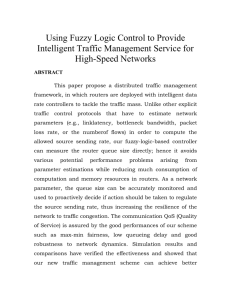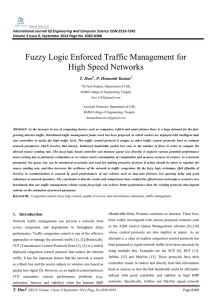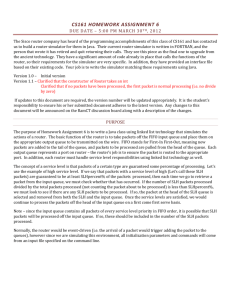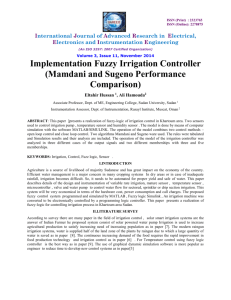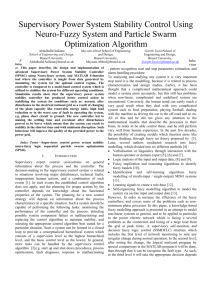Abstract
advertisement
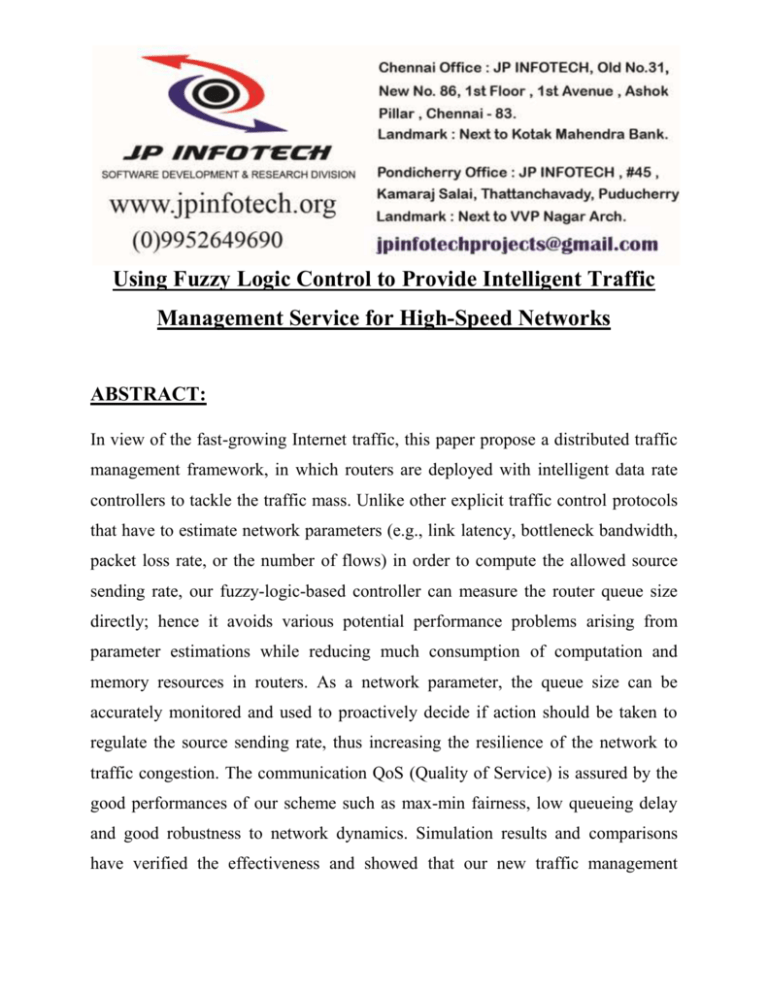
Using Fuzzy Logic Control to Provide Intelligent Traffic Management Service for High-Speed Networks ABSTRACT: In view of the fast-growing Internet traffic, this paper propose a distributed traffic management framework, in which routers are deployed with intelligent data rate controllers to tackle the traffic mass. Unlike other explicit traffic control protocols that have to estimate network parameters (e.g., link latency, bottleneck bandwidth, packet loss rate, or the number of flows) in order to compute the allowed source sending rate, our fuzzy-logic-based controller can measure the router queue size directly; hence it avoids various potential performance problems arising from parameter estimations while reducing much consumption of computation and memory resources in routers. As a network parameter, the queue size can be accurately monitored and used to proactively decide if action should be taken to regulate the source sending rate, thus increasing the resilience of the network to traffic congestion. The communication QoS (Quality of Service) is assured by the good performances of our scheme such as max-min fairness, low queueing delay and good robustness to network dynamics. Simulation results and comparisons have verified the effectiveness and showed that our new traffic management scheme can achieve better performances than the existing protocols that rely on the estimation of network parameters. EXISTING SYSTEM: Historically, TCP (Transmission Control Protocol) is a widely deployed congestion control protocol that tackles the Internet traffic. It has the important feature that the network is treated as a black box and the source adjusts its window size based on packet loss signal. However, as an implicit control protocol, TCP encounters various performance problems (e.g., utilization, fairness and stability) when the Internet BDP (Bandwidth-Delay Product) continues to increase. DISADVANTAGES OF EXISTING SYSTEM: They still have the fundamental problem of inaccurate estimation resulting in performance degradation. In addition, their bandwidth probing speed may be too slow when the bandwidth jumps a lot. Also, they cannot keep the queue size stable due to oscillations, which in turn affects the stability of their sending rates. PROPOSED SYSTEM: The contributions of our work lie in: 1) Using fuzzy logic theory to design an explicit rate-based traffic management scheme (called the IntelRate controller) for the high-speed IP networks; 2) The application of such a fuzzy logic controller using less performance parameters while providing better performances than the existing explicit traffic control protocols; 3) The design of a Fuzzy Smoother mechanism that can generate relatively smooth flow throughput; 4) The capability of our algorithm to provide max-min fairness even under large network dynamics that usually render many existing controllers unstable. ADVANTAGES OF PROPOSED SYSTEM: The queue size can be accurately monitored. Used to proactively decide if action should be taken to regulate the source sending rate. QoS (Quality of Service) is assured by the good performances of our scheme such as max-min fairness, low queueing delay and good robustness to network dynamics. SYSTEM ARCHITECTURE: SIMULATION SETUP: MODULES: 1. Sender 2. Receiver 3. Router Queuing Scheme 4. Network traffic analysis MODULES DESCRIPTION: 1. Sender: Server module is the main module for this project. Inside each router, our distributed traffic controller acts as a data rate regulator by measuring and monitoring the IQ Size. As per its application, every host (source) requests a sending rate it desires by depositing a value into a dedicated field Req_rate inside the packet header. In addition there is also Message Log, where all the alerts and messages are stored for the references. This Message Log can also be saved as Log file for future references for any network environment. 2. Receiver: The receiver then sends this value back to the source via an ACK (Acknowledgment) packet, and the source would update its current sending rate accordingly. If no router modifies Req_rate field, it means that all routers en route allow the source to send its data with the requested desired rate. 3. Router Queuing Scheme: In this module, each router along the data path will compute an allowed source transmission rate according to the IQ Size and then compare it with the rate already recorded in Req_rate field. If the former is smaller System model of an AQM router, than the latter, the Req_rate field in the packet header will be updated; otherwise it remains unchanged. After the packet arrives at the destination, the value of the Req_rate field reflects the allowed data rate from the most congested router along the path if the value is not more than the desired rate of the source. 4. Network traffic Analysis: Using fuzzy logic theory to design an explicit rate-based traffic management scheme (called the IntelRate controller) for the high-speed IP networks; The application of such a fuzzy logic controller using less performance parameters while providing better performances than the existing explicit traffic control protocols; The design of a Fuzzy Smoother mechanism that can generate relatively smooth flow throughput SYSTEM CONFIGURATION:HARDWARE CONFIGURATION: Processor Speed - Pentium –IV 1.1 Ghz RAM - 256 MB(min) Hard Disk - 20 GB Key Board - Standard Windows Keyboard Mouse - Two or Three Button Mouse Monitor - SVGA SOFTWARE CONFIGURATION: Operating System : Windows XP Programming Language : JAVA. Java Version : JDK 1.6 & above.

